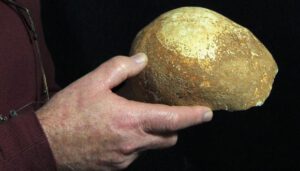A skull found in a previously undisturbed cave in Israel may hold important new evidence about human migration and intermixing with Neanderthals.
The paper published last month by scientists from Tel Aviv University, offers new evidence about the timing of human migration out of Africa, and when those modern humans mixed with Neanderthals. not

Photo: Clara Amit, Israel Antiquities Authority
A New Timeline?
The first anatomically modern humans emerged in Africa about 200,000 years ago. This latest finding appears to support several theories about the timing of the human migration out of Africa as well as the timing of intermixing between humans and Neanderthals.
All non-African people today carry traces of Neanderthal DNA. Based on DNA tests scientists have suggested that the interbreeding likely happened between 50,000 and 60,000 years ago.
A study last year, that used new techniques to more accurately date Neanderthal remains, suggested that Neanderthals and humans may have lived side-by-side for up to 5,000 years. But when and where the Neanderthals and modern humans mixed has been harder to pinpoint.
That’s what makes this study so interesting.
How Old?
Uranium-thorium dating of the skull shows that the remains are about 60,000-to-70,000 years old. Known as the Manot cave, the site is near the town of Haifa and within miles of several other archeological sites where Neanderthal remains dating from that same period have also been found. This suggests that at the very least the two species, homo sapiens and homo neanderthalensis, lived side-by-side in the Middle East during that time.
But the researchers involved in this study believe that the bones show more than that.
New Insights
According to the author of the study, Tel Aviv University Professor Israel Hershkovitz, the shape of the skull bears characteristics found in early modern humans. They are similar to remains found both in Africa and Europe. The skull also shares some characteristics found in Neanderthals. But whether the skull was of a human who had interbred with Neanderthals cannot be determined without recovering DNA from the skull.
Unfortunately, extracting DNA from this skull could prove very difficult. Unlike the remains of other ancient humans that were found in much colder climates where DNA can be preserved longer, these remains have been exposed to much higher temperatures. DNA begins to break down as it’s exposed to microbes, water and oxygen. Ancient DNA tends to be found in very small quantities and is often fragmentary or damaged.
So far the oldest human DNA was extracted from a bone found along a Siberian riverbank of a man who lived 45,000 years ago.
![]()
Got Neanderthal DNA?
23andMe customers can find their inner Neanderthal or at least how much Neanderthal DNA they have. Not yet a customer? Visit our store!



